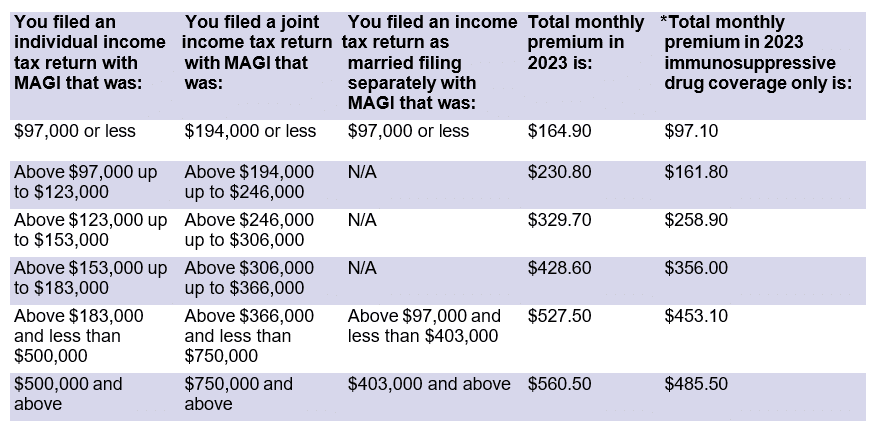The new Medicare premiums and Social Security cost of living adjustments (COLAs) have been announced. To learn about the updates, please continue reading below:
Medicare
Medicare’s Open Enrollment Period — which runs from October 15 through December 7 — is your annual opportunity to switch your current Medicare health and prescription drug plans to ones that better suit your needs. Just in time for Open Enrollment, 2023 Medicare premiums, deductibles, and other costs have been announced, and surprisingly, some of these costs are lower than they were last year.
What to consider
Start by reviewing any materials your plan has sent you. Look at the coverage offered, the costs, and the network of providers, which may be different than last year. Maybe your health has changed, or you anticipate needing medical care, or new or pricier prescription drugs. If your current plan doesn’t meet your healthcare needs or fit your budget, you can make changes. But if you’re satisfied with what you currently have, you don’t need to do anything. The coverage you have will continue.
During Open Enrollment, you can:
- Switch from Original Medicare to a Medicare Advantage Plan
- Switch from a Medicare Advantage Plan to Original Medicare
- Change from one Medicare Advantage Plan to a different Medicare Advantage Plan
- Change from a Medicare Advantage Plan that offers prescription drug coverage to a Medicare Advantage Plan that doesn’t offer prescription drug coverage
- Switch from a Medicare Advantage Plan that doesn’t offer prescription drug coverage to a Medicare Advantage Plan that does offer prescription drug coverage
- Join a Medicare prescription drug plan (Part D)
- Switch from one Part D plan to another Part D plan
- Drop your Part D coverage altogether
Any changes made during Open Enrollment are effective as of January 1, 2023.
Medicare Part B (Medical Insurance) costs for 2023
Most people with Medicare who receive Social Security benefits will pay the standard monthly Part B premium of $164.90 in 2023. This premium is $5.20 lower than it was in 2022 due to lower-than-projected spending for a new drug, Aduhelm, and other Part B items and services.**
People with higher incomes may pay more than the standard premium. If your modified adjusted gross income (MAGI) as reported on your federal income tax return from two years ago (2021) is above a certain amount, you’ll pay the standard premium amount and an Income-Related Monthly Adjustment Amount (IRMAA), which is an extra charge added to your premium, as shown in the following table:

*This premium applies to a new benefit that extends coverage for immunosuppressive drugs for people who qualify for Medicare coverage due to end-stage renal disease. Prior to 2023, Medicare coverage, including immunosuppressive drug coverage, ended 36 months after a successful kidney transplant.
People with higher incomes may also pay a higher premium for a Medicare Part D prescription drug plan because an IRMAA will be added to the Part D basic premium based on the same income limits in the table above. Part D premiums vary, but the average basic monthly premium for 2023 is projected to be $31.50 (down from $32.08 in 2022).
People with Medicare Part B must also satisfy an annual deductible before Original Medicare starts to pay. For 2023, this deductible is $226 (down from $233 in 2022).
Beginning January 1, 2023, Medicare will offer a new benefit that will help continue to pay for immunosuppressive drugs beyond 36 months for people who don’t have other health coverage. It does not cover other items or services. Rates shown apply to people who file individual or joint tax returns.
Premiums for beneficiaries filing as married filing separately are different.
Medicare Part A (Hospital Insurance) costs for 2023
- Part A deductible for inpatient hospitalization: $1,600 per benefit period (up from $1,556 in 2022)
- Part A premium for those who need to buy coverage: up to $506 per month (up from $499 in 2022) — most people don’t pay a premium for Medicare Part A
- Part A coinsurance: $400 per day for days 61 through 90, and $800 per “lifetime reserve day” after day 90, up to a 60-day lifetime maximum (up from $389 and $778 in 2022)
- Part A skilled nursing facility coinsurance: $200 for days 21 through 100 for each benefit period (up from $194.50 in 2022)
**The Centers for Medicare & Medicaid Services, 2022
Social Security
On October 13, the Social Security Administration announced its COLA for 2023 which will be 8.7%. This represents an increase from 5.9% in 2022. The increase is set to take effect with the January 2023 Social Security payment. What is interesting for 2023 is that the increase from the Social Security COLA is coupled with a slight decrease from Medicare Part B premiums. Typically, a rise in Social Security corresponds with a rise is Medicare premiums, however this is not the case in 2023.
Peak Asset Management, LLC is an SEC registered investment adviser. This is not an offer to buy or sell securities. Past performance is not indicative of current or future performance and is not a guarantee. The purpose of the blog is solely informational and does not constitute investment and/or tax advice. The information set forth herein was obtained from sources which we believe to be reliable, but we do not guarantee its accuracy.
share article
Get our latest insights
Subscribe to our quarterly newsletter for all the latest news and information about investing and financial planning.
